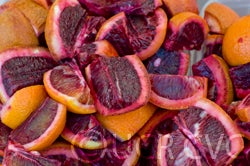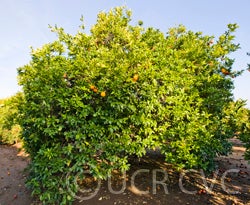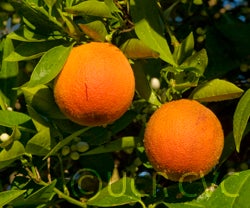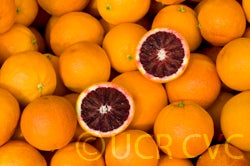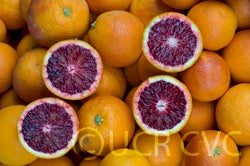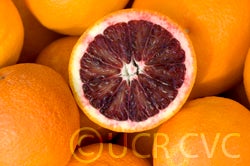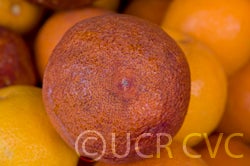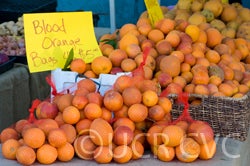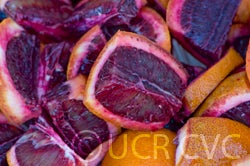Citrus sinensis (L.) Osbeck
CRC 3830
PI 539554
VI 362
Source
Received as budwood from USDCS, Indio, CA, via CCPP, 1975.
Parentage/origins
Parents unknown
Rootstocks of accession
Carrizo citrange, C-35 citrange
Season of ripeness at Riverside
December to February
Notes and observations
EMN, 2/4/1988- Appears to be identical to CRC 3811- Moro. Nearly seedless, flavor fair, not as good as Ruby or Tarocco. Best external color is on fruits on north side of trees. See blood orange color comparison chart on back of CRC accession card #3152.
OJB: The tree is of moderate vigor and size with a round and somewhat spreading growth habit. The fruit is round, of moderate size, and frequently borne in clusters. The orange-colored peel is commonly blushed with a burgundy color. Moro is the most highly-colored of the blood oranges, owing its distinctive flesh color and rind blush to the presence of anthocyanin, the same pigment that colors purple grapes. Moro is also the earliest ripening of the blood oranges and is usually mature at Riverside in January. The fruit is usually low-seeded with a flesh that can become very dark red late in the season. The fruit holds well on the tree, but develops an off-flavor if held too long. The color and flavor develop best in the warm inland valleys.
Description from The Citrus Industry Vol. 1 (1967)
"Moro blood orange is the most common of the pigmented oranges marketed in the United States. It is of relatively recent origin and is believed to be of Sicilian ancestry. Fruit medium to medium-large, subglobose, round or obovoid; base somewhat furrowed; apex commonly flattened; areole faint or lacking; seeds few or none, but with chalazal spot purplish-red. Rind medium-thick, moderately adherent, and somewhat pebbled. Orange-colored at maturity with light pink blush or red streaks at advanced maturity. Flesh deeply pigmented (almost violet-red); juicy; flavor pleasant. Very early in maturity (earliest of the commercial blood oranges), but holds well on the tree and stores and ships well. A distinctive aroma develops with advanced maturity, but flavor deteriorates if held too long in storage and becomes objectionable to some.
Tree of medium vigor and size, spreading and round-topped; very productive fruit (generally in clusters of three or more).
Moro is distinctive in that pigmentation develops early and strongly in the flesh, ranging from medium to intense, whereas rind pigmentation may be lacking or at best only moderately developed. Thus, the Moro does not develop external pigmentation in the coastal area of southern California, where conditions are unfavorable to development of blood coloration, but almost always exhibits far more internal coloration than any other variety. This variety undoubtedly belongs to the deep blood group.
Of comparatively recent Sicilian origin and thought to have developed from the Sanguinello Moscato variety, Moro did not attain the popularity of Tarocco for several decades. More recently, it has been planted to a considerable extent in Sicily, where it now enjoys equal favor."
Availability
Commercially available in California through the Citrus Clonal Protection Program. Click here to order budwood.
USDA Germplasm Resources Information Network page for Moro blood orange (CRC 3830)

